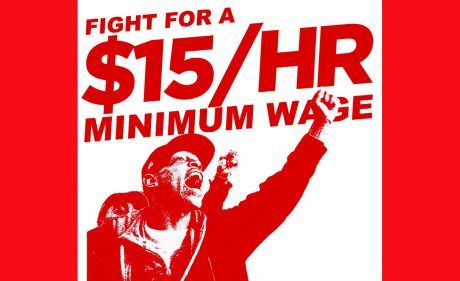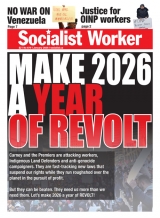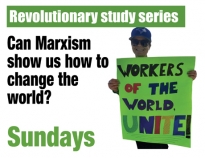Features
You are here
Building working-class solidarity: The fight for $15

March 29, 2015
Ontario’s Campaign to Raise the Minimum Wage and the Fight for $15 movement in the United States have renewed the struggle for decent work by raising class demands and uniting workers across sectors in a manner unprecedented in recent decades. Building on gains in the US, the movement in Ontario has begun raising the minimum wage. Now there’s a campaign for $15 in Ontario, BC and Nova Scotia, raising the possibility of a pan-Canadian campaign uniting unionized and non-unionized workers around a common demand. The next global day of action for the Fight for $15 is set for April 15, 2015 when union and non-union workers across North America – and indeed the globe – are mobilizing for decent wages and decent work.
Fight for $15
In the fall of 2012, US workers in New York City and Chicago, supported by the Service Employees International Union (SEIU), United Food and Commercial Workers (UFCW), and other unions, launched the Fight for $15 movement when handfuls of workers in the "virtually union-free" retail and fast food sectors walked off the job. This extraordinary action did not arise spontaneously. It was the result of months of organizing that was informed by an explicitly working-class agenda, and consciously intended to rebuild links between organized and unorganized workers. The strategy is designed to overcome the class fragmentation and absence of bargaining power that is especially pronounced in the service sector where fast food and retail jobs are among the fastest growing occupations in the country.
Within two years, the Fight for $15 has exploded into a national movement across the US. Workers at hundreds of outlets in hundreds of cities have engaged in strikes and walkouts. Among the emerging leadership of these movements are young, racialized workers—especially women—who are reshaping the movement and, in the process, themselves. The minimum wage is now a topic for debate at all levels of government in the US. Indeed, on January 1, 2015, three million workers received a legislated wage increase as 20 states and Washington, DC raised minimum wages. Three municipalities—SeaTac and Seattle in Washington, and San Francisco in California—have voted to establish a $15 minimum wage and other improvements in working conditions such as paid sick leave, fairer hours and successor rights for workers. In February, New York City Mayor Bill de Blasio pledged to begin work on a $15 minimum wage ordinance for all workers in the city, and Portland city council amended its Fair Wage policy to establish a $15 minimum wage for the city’s directly-hired and contracted employees. None of this would be taking place were it not for the growing confidence and willingness to fight of the lowest paid members of the American working class—bolstered by the solidarity offered by the organized labour movement.
Seattle
Fifteen years after Seattle made headlines when labour and social movements converged to shut down the World Trade Organization, Seattle-area workers achieved the first $15 minimum wage breakthroughs. Residents in the Seattle suburb of SeaTac voted on November 5, 2013 to adopt Proposition 1 that implements a $15 minimum wage as well as providing a modest number of paid sick days, requiring employers to offer additional hours to existing part-time workers before hiring new staff, and, significantly, requiring employers retain employees for at least 90 days if the business is sold. These measures have made a real difference in the lives of workers affected.
Meanwhile, right next-door in Seattle, Kshama Sawant put the Fight for $15 at the centre of her bid for city council. Her campaign not only helped defeat incumbent city Councilor Richard Conlin—himself a Democrat—but also forced the Fight for $15 right into the centre of Seattle’s mayoral contest. As David Goldstein describes: “By October, the three-pronged $15 movement—the fast-food strikes, the SeaTac $15 initiative, and the insurgent Sawant campaign—was dominating local political headlines. Eager to win both street cred and labour endorsements, both candidates in Seattle's hotly contested mayoral race suddenly jumped on board, promising a $15 minimum-wage ordinance if elected. Several council members followed suit. … The movement turned the November election into a referendum on the $15 minimum wage, and the message from voters was clear. By the end of December, eight of nine Seattle city council members had publicly endorsed a $15 minimum wage.”
Having defeated the incumbent mayor Michael McGinn, the new mayor, Ed Murray, immediately implemented a $15 minimum wage for all directly-hired and contracted employees of the City of Seattle, a move that raised the wages of approximately 600 people. He then helped forge legislation that will bring all workers in the city to $15 an hour between 2017 and 2021. By 2025, all minimum wage workers in Seattle will receive $18.13. It is expected that one in every four Seattle workers—or more than 100,000—will benefit from the minimum wage ordinance.
By identifying the correct target – a $15 minimum wage for all workers within Seattle’s legal jurisdiction – the movement created enough pressure to force the city to raise the wages of its own directly-hired or contracted workers and then extend that victory to all workers. In this context, the pay increases for the 600 public-sector city workers (and those funded by city contracts) could be understood as a down payment on the ultimate goal of winning decent wages for all workers, not as “another unfair pay hike” for a “privileged” section of the workforce. By contrast, had the Seattle movement started by campaigning only for those 600 city workers, it is doubtful the movement would have been as effective, because it would not have had such broad class appeal. This aspect of the US movement must be fully grasped if we are to learn the lessons from the campaign and apply them elsewhere.
Strategy
Seattle’s municipal campaign can’t simply be transplanted into Canada. Because cities don’t have the legal authority to make laws that apply to all workers within its boundaries, a statutory approach in the Canadian context can’t just focus on a city; it must focus on the province. And that requires a united, province-wide campaign for a common minimum standard.
To do otherwise, leaves workers in precarious employment to the tender mercy of their individual employers. And because such workers lack bargaining power in individual worksites, their employers will have little reason to “do the right thing” in the face of moral pressure from the outside. Effective campaigns must aim to force employers into compliance, either through a collective agreement or through law; it is this that gives the workers a stake in the outcome of the campaign and creates an incentive to participate.
The class raises the floor, unions set the bar
The growing gap in living conditions between workers in decent jobs and workers in low-wage, unstable, temporary, and involuntary part-time employment is a strategic threat to the gains union and non-union workers have won together. There is an urgent need for a working-class project to rebuild the floor in wages and working conditions. And engaging workers in small workplaces, in unstable and low-wage employment is a critical strategic question for the labour movement.
As David Rolf, President of SEIU Local 775 and a leader in the SeaTac $15 initiative, explains: “We can't be the movement that's just about us. The labor movement that workers flocked to by the tens of millions in the 1930s wasn't known for negotiating 500-page contracts. They were known for fighting for the eight-hour day, fighting to end child labor." This insight reminds us all that workers join unions—and pay dues—when they see the need for organization as part of a larger project to improve working conditions. Unions are a means to an end, not the end itself. And we must remember that all union contracts and labour laws reflect a particular balance of class forces at any given moment.
The challenge for unions in general is that, while solidarity from unorganized workers (or differently organized workers) is increasingly crucial to winning workplace collective bargaining demands – and setting the bar higher for wages and working conditions – it is not always clear to union members how to develop campaigns that will improve conditions for workers without unions (or for those in unions who lack bargaining power). This is especially significant when one considers the fact that in Ontario the minimum wage has been frozen for 12 of the past 20 years. The minimum wage increases that have occurred didn’t trickle down accidentally from individual collective bargaining victories; the increases came as a result of deliberate, united, working class effort that made provincial, legislative change the central focus.
This approach is a bit different from regionally focused living wage campaigns. While regional living wage campaigns help expose the gap between what workers earn and what they need to live decently in their particular locale, these campaigns call for voluntary compliance, and therefore tend to focus on employers that are progressive, stable or big enough to extend wage improvements, while leaving the worst employers unmoved. And on a cautious note, the regional diversity inherent in living wage calculations opens a door that allows some employers to claim they are paying too much, rather than not enough. As a case in point, last September, Maclean's magazine explicitly called for the creation of local minimum wages, noting two Canadian jurisdictions where the author claims the minimum wage is too high.
Ontario Campaign to Raise the Minimum Wage
In less than two years, the Ontario Campaign to Raise the Minimum Wage won two historic milestones. In June 2014, the general minimum wage increased from $10.25 to $11.00 an hour and, in November that same year, the Ontario government was forced to index the minimum wage annually to keep up with increases in the cost of living. For minimum wage earners, this represents a 7 per cent bump in wages and it means their earning power will no longer be eroded in the years between statutory minimum wage increases. The first cost of living increase will take effect October 1, 2015 when the general minimum wage will be $11.25.
But even beyond its success in forcing legislative reform, Ontario’s Campaign to Raise the Minimum Wage has been politically significant. The campaign has provided non-union and union workers an opportunity to unite across workplaces and across the province. This is the kind of common struggle that most quickly allows unionized workers to shed their pre-conceived notions of charity and pity toward low-income workers, and helps low-income workers lose their resentment and bitterness toward unionized workers. Without effective, common, provincial campaigns with outcomes that apply to the working class as a whole, the process of building real working class power will be harder, slower and less effective.
Two years ago, some in Ontario were hesitant to embrace the idealism of a $14 minimum wage and in the 2014 election the Ontario New Democratic Party refused to endorse it. Yet thanks to the Ontario and US movements, a Fight for $15 campaign has been launched by the BC Federation of Labour and by labour, students and community groups in Nova Scotia. Even the federal NDP feels confident enough to make a $15 federal minimum wage part of its election platform and hundreds of canvassers will be door-knocking on this issue in the lead-up to the federal election next October.
Fight for $15 and Fairness
The Fight for $15 movement is clearly resonating with union and non-union workers: in Ontario, labour and community groups in more than 25 towns and cities are launching the Fight for $15 and Fairness campaign—where fairness means a modest number of paid sick days, fair hours and scheduling, measures to make it easier to join unions, and meaningful enforcement of employment laws so that all workers have dignity and respect at work. These aspects of fairness are critical in light of the Ontario government’s recently announced 18-month public consultation on employment laws. As OFL President Sid Ryan notes, the consultation offers Ontario workers a once-in-a-generation opportunity to affect meaningful, provincial statutory change. These issues will be an important part of the OFL/Common Front's Solidarity Against Austerity Summit taking place in Toronto on April 17-18.
The next global day of action for the Fight for $15 is set for April 15, 2015 when union and non-union workers across North America – and indeed the globe – are mobilizing for decent wages and decent work. This kind of convergence of movements is relatively rare in history; seldom do we get a chance to unite concrete working-class struggles across provincial and national borders. Yet here we are, on the precipice of just such an opportunity. To join or organize an action in your town or city visit: http://raisetheminimumwage.ca, http://15andfairness.org, (ON); http://www.fightfor15bc.ca (BC); http://fightfor15.org (US); http://april15.org. To register for the Common Front Anti-Poverty Assembly visit: http://weareontario.ca/index.php/antipovertyassembly/.
If you like this article, register for Rage Against the System, a weekend conference of ideas to change the world, April 24-26 in Toronto. Sessions include "Why is capitalism in crisis?" "Precarity and the fight against austerity," and "Gravediggers of capitalism: the working class and socialism from below."
Section:










